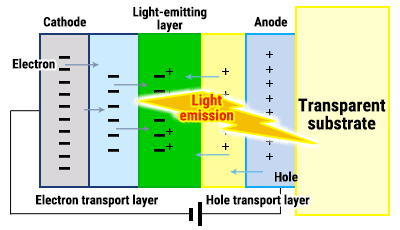- Top
- What is OLED lighting?
- Mechanism of OLED lighting
Mechanism of OLED lighting
Thin organic layers between two electrodes emit light
Fig.1 shows the mechanism of OLED device. An OLED device consists of a plurality of functional organic layers including a hole transport layer, a light-emitting layer, and an electron transport layer, and all of these layers are situated between an anode and a cathode. In an OLED device, the light-emitting layer is excited by the recombination energy of electrons from the cathode and holes from the anode, and then the light-emitting layer emits light when returning to the ground state. One of the electrodes consists of transparent material in order to extract light from the light emitting layer.

Figure 1. Mechanism of light emission by OLED lighting
In addition, the light color depends on the chemical structure of light-emitting material, therefore it can be controlled freely by material design. White color OLED lighting is fabricated by adjusting red, green and blue light-emitting materials to the appropriate ratio.
Difference from OLED display
OLED lighting is required to be a uniform white surface light source, so it is fabricated by laminating each large area RGB light emitting element. On the other hand, OLED display is fabricated by arranging each small RGB lighting pixels side by side.
Structure of OLED lighting


R+G+B=White
Lumen output is required for lighting application.
Structure of organic EL display

Various colors can be expressed by adjusting the brightness of each RGB pixel. Too much brightness cause eye fatigue since we watch the display surface directly.
Difference from LED lighting
The basic principle is identical. OLED emits light by conducting electricity to the organic materials that are sandwiched between the electrodes. On the other hand, LED emits light by conducting electricity to inorganic materials that are sandwiched between electrodes. The features of each lighting type are as follows.
| OLED lighting | LED lighting |
|---|---|
|
|

